WORLD CLASS COACHING
How Pep Guardiola Wins with Inverted Fullbacks
By Mike Smith
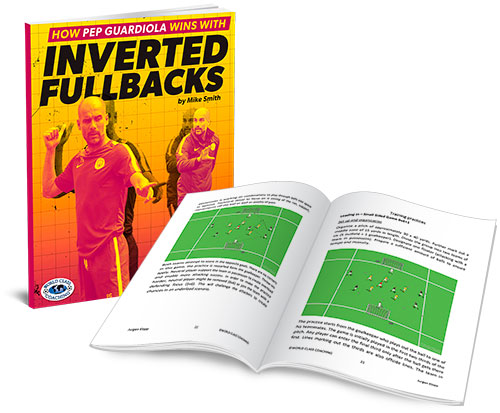
Table of Contents
PART ONE
INTRODUCTION
WHAT IS AN INVERTED FULLBACK?
CONDITIONS TO MAKE INVERTED FULLBACKS WORK
PART TWO
TACTICAL ADVANTAGES OF INVERTED FULLBACKS
PART THREE
DISADVANTAGES OF INVERTED FULLBACKS
PART FOUR
FLUIDITY
HOW YOUR TEAM CAN USE INVERTED FULLBACKS
BRINGING IT ALL TOGETHER
Introduction
Right now Manchester City is on an unprecedented streak of play at one of the highest levels of soccer. While there are many reasons for this, the major point of focus has been their use of the inverted fullback, which Jonathan Wilson in his article for the Guardian called “flying fullbacks.” Pep Guardiola has always been known as a tactician and this year perhaps more than any other, his Man City side are proving him to be a master.
The following is not an analysis of Manchester City or Pep Guardiola as a whole, but a breakdown of how they are using inverted fullbacks to win games, and how your team can do it as well. The breakdown, which will include diagrams and game footage, will look at 6 areas – What is the Inverted Fullback, What are the Conditions Required to Make Them Work, What are the Tactical Advantages, What are the Tactical Disadvantages, Fluidity, and How to Implement Inverted Fullbacks into Your System.
WHAT IS AN INVERTED FULLBACK?
An inverted fullback is an outside defender who, instead of looking to get out on the line and work the ball up wide, gets right up into the central areas of the midfield, specifically into the area between the forward and midfield lines of the opponent. It is also beneficial if the player can play on the side opposite of their strong foot, i.e., a left foot-dominant back playing on the right side. Certainly at the professional level where most players, while having a preferred foot, are competent with both feet this is less of a factor in the decision to play inverted. After thoroughly analyzing Man City’s use of the position, I think it comes down to utilizing the central areas of the pitch as the best distribution point and getting numbers up at every line (forward, midfield and defensive).
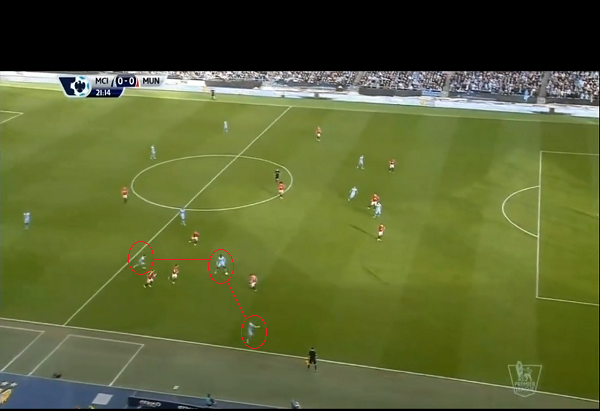
This is a shot from Manchester City vs. Manchester United in 2014. This shows a “traditional” 4-4-2 shape and attack/advance the ball wide concept. The outside defender (bottom left circled) has used the width of the field to pull out two opposing players, which opens space in the mid field. Here the outside defender has just passed to a central midfielder (bottom center circled), which draws more opposition back into the center freeing space on the wing. The central midfielder then uses the wing midfielder (bottom center right circled) to exploit the wide space and serve it in to the two forwards and other wing mid. This is offered as a comparison to how Manchester City are playing now with their fullbacks inverted. While most coaches will readily admit the central parts of the field are the best distribution points--because of the ease, speed, and unpredictability of being able to simply connect both sides of your formation and the entire width and length of the field--few consistently break from the tried and true approach shown above.
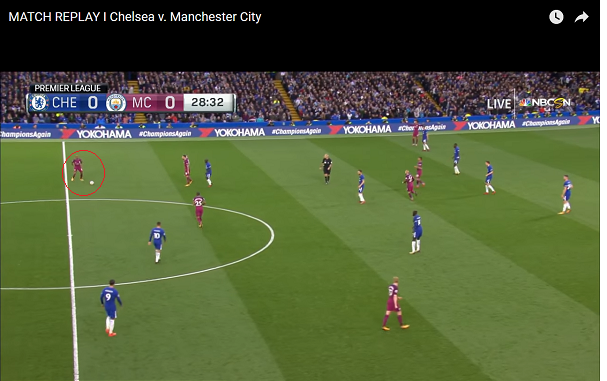
In this clip from Man City’s match with Chelsea this season (2017), the use and intent of the inverted fullback (circled on the ball) is clear. The body language of the team, when compared with the previous clip from 2014 is clear as well. Instead of looking to blast up the wing or play wide up the left side, which is still an option, the inverted fullback is clearly looking to distribute centrally, with the only player obviously ready to blast up the field wide being the OPPOSITE side forward. Had the outside back NOT inverted, and been pinched out on the line, the switch to the right side forward would not have been a viable attacking option. We will look at the tactical implications of this later on. Without getting too far ahead, a quick count of the numbers in the scenario above speaks volumes to the impact of the inverted fullback as Chelsea has 9 players in the frame compared to only 7 for Manchester City. Even though Chelsea has numbers up--3 Man City players are clearly unmarked and somewhere off frame--Man City has a 3 v 1 advantage.
For me, the main impact of the inverted fullback is twofold – the obvious aggressiveness of the tactic cannot be overlooked – but the main impact is the ability the position gives Manchester City to easily link the entire field together. However, the use of the inverted fullback involves way more than putting a left footed guy on the right side of your back line and running him up high and central. As the next chapter will show, there are several conditions which also come into play in making the use of the inverted fullback a success. Something I found interesting from the 2014 game shown in the first clip (which was before Pep Guardiola) was the moment Manchester United went down a man, Man City adopted a much more aggressive approach, in fact perhaps foreshadowing what was to come.
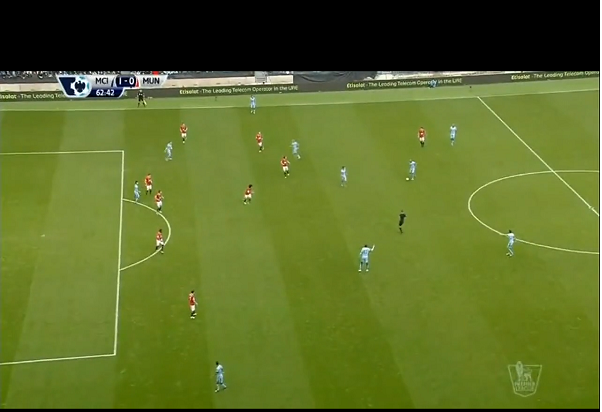
With virtually no pressure from the lone Manchester United forward, Man City readily pushed up centrally with their back line. Able to connect the entire field, Man City was able to tack on their second goal (shown below) with a through ball into the box behind a sliding Manchester United defender when United was forced to hold in the middle.
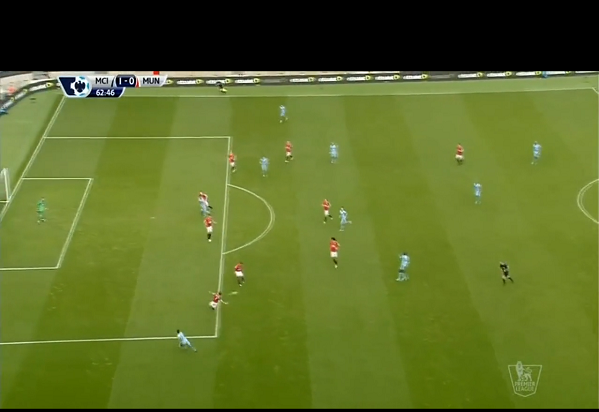
I include this to support the fact playing with inverted fullbacks is an aggressive approach. Most coaches will admit the immediate response to going a man up is “Now we can get more aggressive.” Manchester City unknowingly showed signs of things to come in 2014 by choosing to be more aggressive after being given the opportunity. Now, under Pep Guardiola and his inverted fullbacks, Man City are being aggressive by design and creating these opportunities from start to finish.
Below is perhaps the best example I have seen of what the inverted fullback can do, and while done in another man up situation, this time it was a matter of purpose according to the plan.
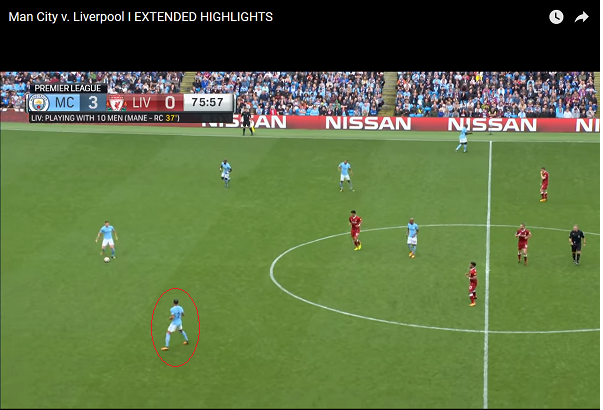
After some deliberate possession, Man City #2 (Walker) drops in to receive the ball from the center back as it is being swung around. Again, Liverpool is a man down at this stage, playing a 4-4-1, but the additional player up top would have made little difference in the outcome of this possession.
As seen in the clip below, Walker makes no effort to turn and use the wide areas of the field, but instead sends the ball directly back to the left side. The problem is, there is so much space available to work that the Liverpool players must be ready to cover every section of the field. This aspect of using an inverted fullback will be covered in detail later, but the advantage can clearly be seen in this clip.
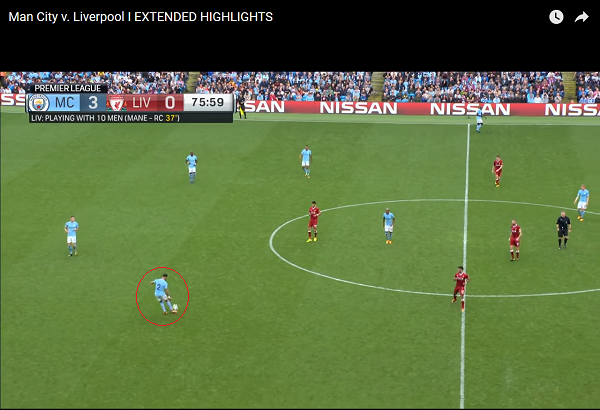
With the Liverpool midfield holding centrally and ball watching (above), an easy split is found, which brilliantly takes out 3 of the 4 opposing midfielders and puts them squarely behind the play (below).
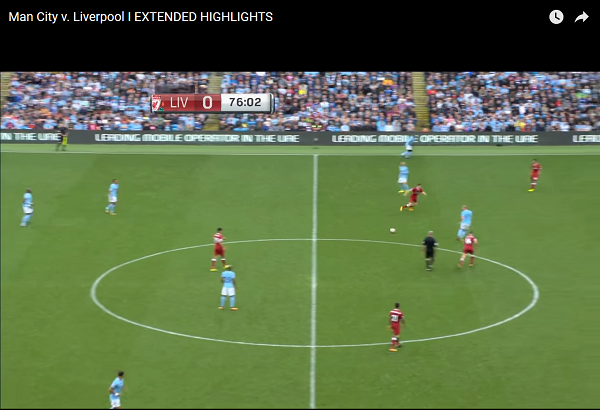
Another beautiful pass puts all 9 Liverpool field players chasing the play (next clip)
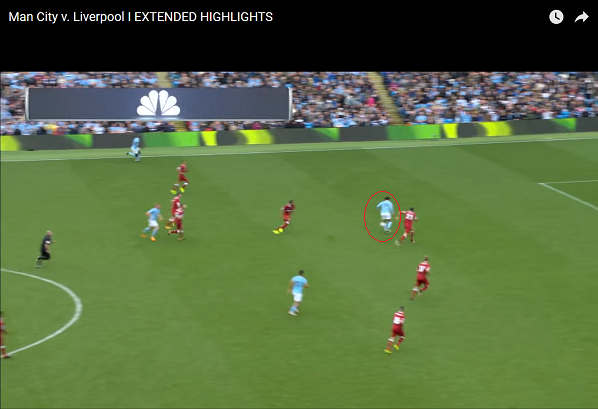
Had the inverted fullback played traditionally and gone wide at the start of this run, Man City very may well have scored. However, it is almost certain all of the Liverpool players would have been behind the ball, facing the play and had better awareness of their marks. Again, much more to come on this in the following pages. But as the next two clips show, by making the opposing side defend the entire field with simple, on the ground, connecting passes between the lines, Man City rings one up fairly easily here.
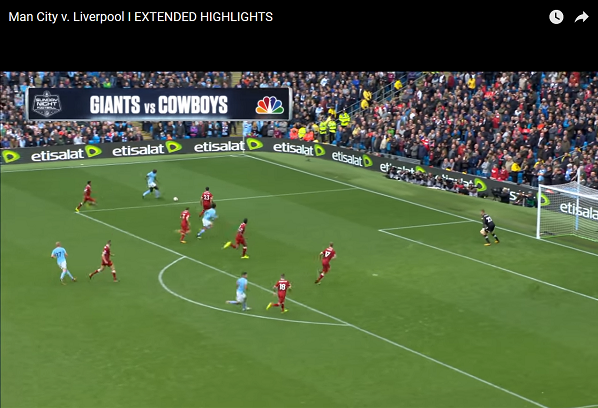
The ball is sent perfectly across to the near post runner and can be seen going in on the final clip below (circled in red).
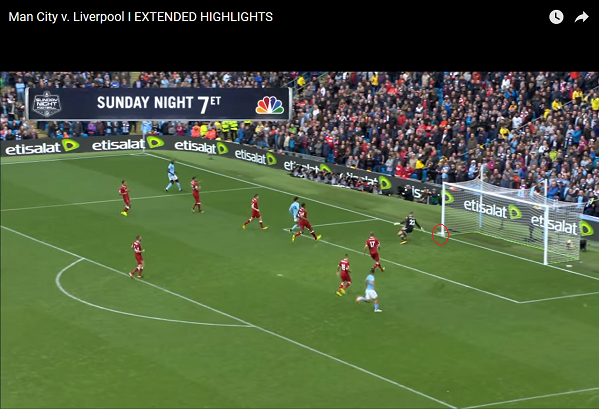
There is no better example of what an inverted fullback is and what playing this way can do than can be seen in the previous 6 frames.
CONDITIONS TO MAKE INVERTED FULLBACKS WORK
Pep Guardiola calls his formation a 4-3-3, and when starting the game and being caught without the ball, Manchester City often times shows this basic shape on the field. In the clip below, while the outside backs are pushed up and into the center a bit, the 3 forwards and 3 midfielders are clearly visible at kick off. Also clearly visible is the holding central mid, which is the first element which really helps to make playing with inverted fullbacks work.
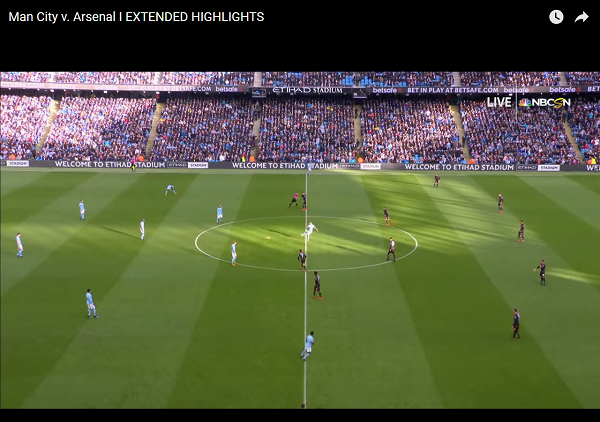
Below Man City shows a very compacted 4-3-3 during the run of play as well, with only the wide forward not visible in the shot. This is another key condition to making the inverted fullback work – the team moves together to make the concept work and they are all very situationally aware of when to play, for lack of better terms, “traditionally” and “non-traditionally.” I consider this situational awareness to be part of Manchester City’s overall fluidity and will cover this further later on.
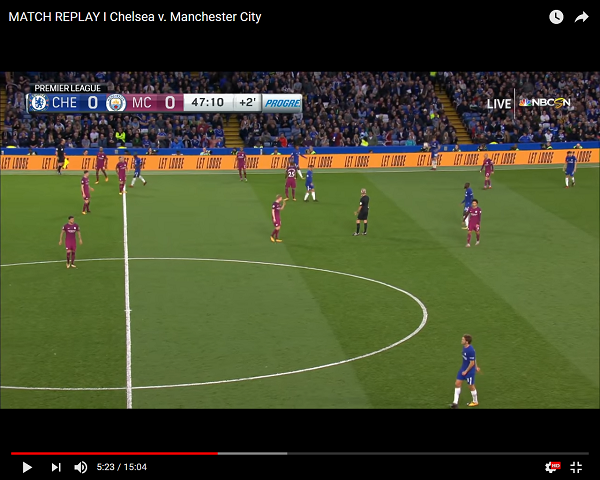
While their team fluidity is important, these elements are important on any team with any system. Manchester City has become unique with their inverted fullbacks largely in part to the work of the holding mid. As shown below, and to be seen in several following clips, the discipline of their holding mid (#25 circled below) is critical to the success the “flying” inverted fullbacks have had.
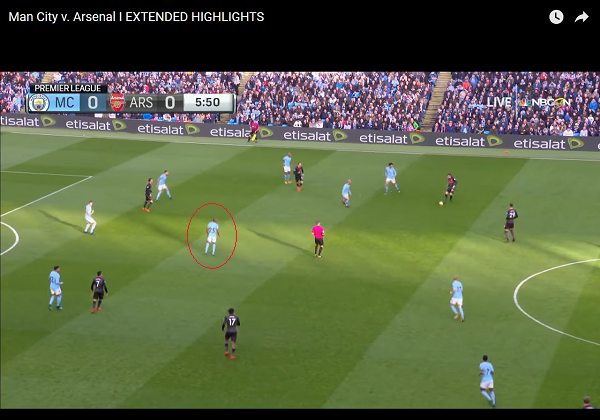
Still referencing the above clip, the holding mid’s positioning here allows the fullbacks to press up and in to aggressively mark their attackers and as will be seen later, Man City is actually funneling the Arsenal attack into the central areas of the field to try and bait them into forcing the ball wide, where Manchester City is then usually able to steal the ball and counter. While the other midfielders and forwards are all doing their respective parts to create pressure, the holding mid’s discipline here is what makes the concept work. This may not seem noteworthy when talking about the Premier League or any other high level professional league – most professionals are disciplined team players. However, those of you reading this from a club, high school or even collegiate level who may be considering playing with inverted fullbacks need to understand how critical the holding mid position is to making it work.
The second key elements are the center backs. As shown above, when defending, the center backs work well together and form a relatively tight area in not just the center of the field – but also the center of the formation. This in itself is important. Their biggest benefit, however, in the use of inverted fullbacks, is when transitioning into possession.
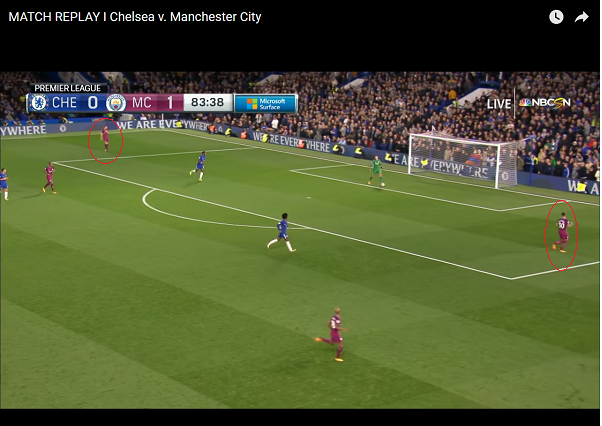
As the above clip shows, the two players circled in red are the CENTER backs. This is during the run of play from a pass back to the keeper and is a staple of the current Man City approach. ANY time the keeper has the ball, the center backs split out to the top corners of the box, i.e., the wide areas of the field, for the supporting pass. This immediately opens up the holding mid in the center and while the ball side fullback can go wide, they most commonly get right up between the opponents forward and midfield line. In my opinion, the center backs, and keeper for that matter, HAVE to be proficient at this. Combined with the holding mid, this immediate movement creates a 4 v 2 and basically ensures possession. In the case seen above, the field is spread so wide the keeper has a straight shot up to the forward line (following clip). The center forward heads the ball back to the oncoming mid, who distributes out to the right forward. (as shown in next two clips).
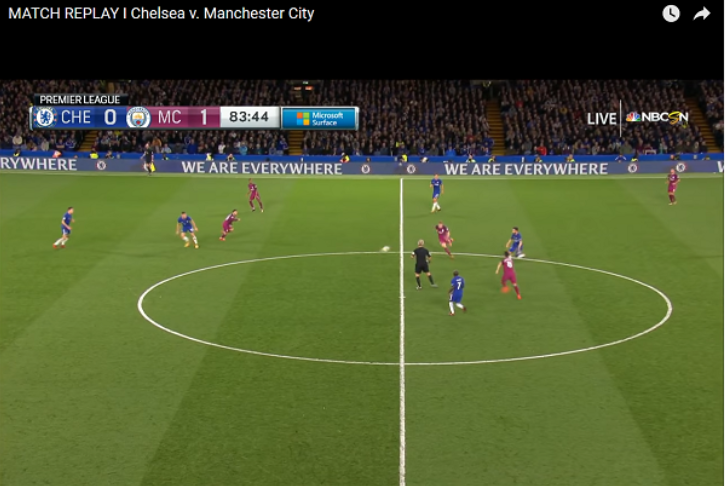
16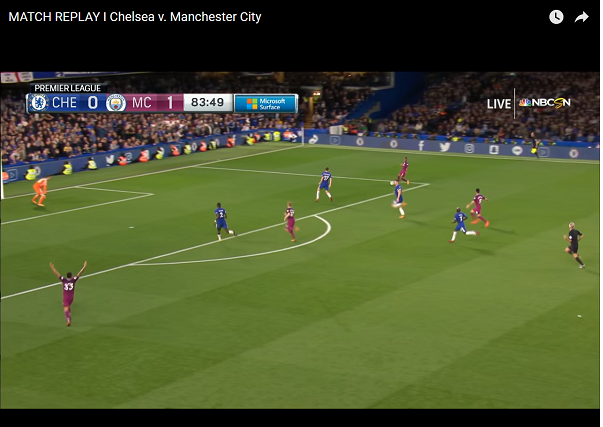
I know it seems odd to show shots in a book dedicated to the inverted fullback, which contain every player EXCEPT the inverted fullback, but this goes to show the extent to which their aggressive play and ability to stretch and connect the field frees up the other positions, especially the 3 attackers up top. The result, as shown below, is a wide open shot, well-taken but deflected off the head of a well-positioned Chelsea defender.
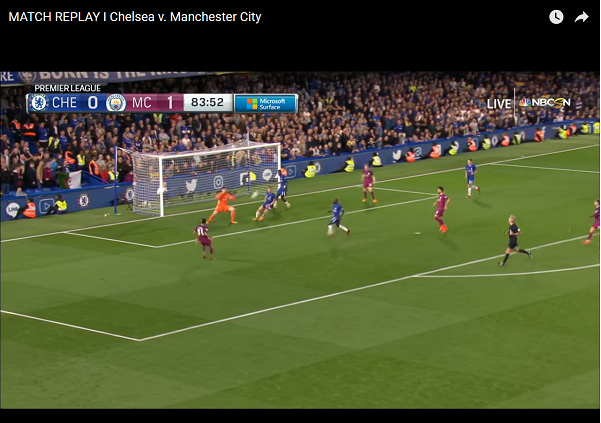
So, on top of the standard desirable aspects of any team , including what I call Fluidity (mobility, situational awareness, discipline, etc…) the two most important supporting pieces to the inverted fullback puzzle are how the holding mid and center backs work to support the overall aggressive concept/style of play. The next chapter looks at the exact tactical implications of the inverted fullback in detail.


